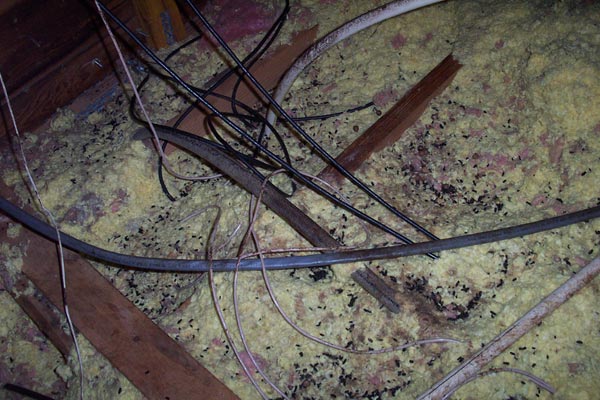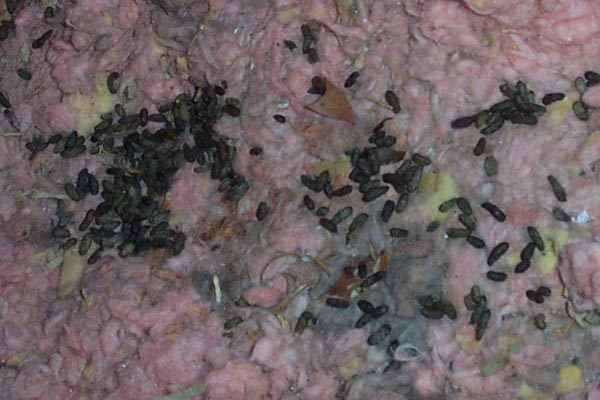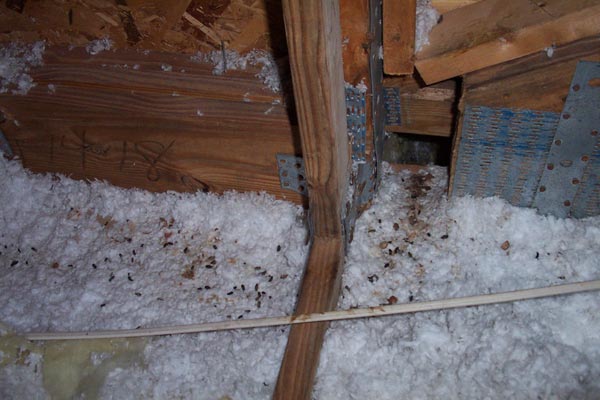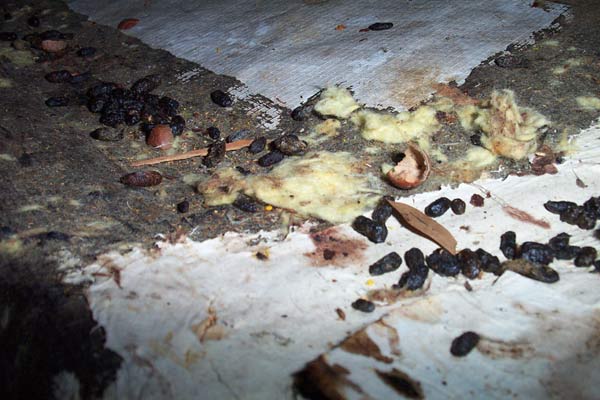-
info@aaanimalcontrol.com
Call us for help in your town
Humane Wildlife Education
Rats Leave Droppings (Poop) in the Attic
Need rat removal in your hometown? We service over 500 USA locations! Click here to hire us in your town and check prices - updated for year 2020.
The below photographs were taken from attics that I've worked in. These attics all had rat infestations. Sometimes up to 15 rats, sometimes as few as 3. These photos
should help you to identify the droppings you see in the attic of your home. Read my Educational article - how to get rid of rats to learn more.

This attic was heavily contaminated with rat poop. Rats had been living in this attic for a long time. You can see that
they've left their droppings everywhere, but also note that most of the insulation is trampled down. It's
not light and fluffy, it's matted and greasy, coated with urine. Suffice it to say, it smelled bad. The smell
attracts new rats for years to come.

In some attics, there are so many rats that the droppings really pile up thick. I recommend that you
have the droppings cleaned if they are in high numbers, due to the odor and biohazard that they cause.
Not only can new rats smell the odor of previous rats, but the droppings may be dangerous to people.
Rats also urinate, of course, and one rat can urinate up to three gallons per year.

Rats often travel the same routes over and over again. Observe how they entered this portion of the
attic through a gap, and traveled a route along the wall. When trapping rats, it is important to place
the traps right on the travel routes. Rats are cautious by nature, and usually won't go out of their way
to seek out the traps. Trap location is the key to success.

Rats and squirrels can drag acorns and other nuts into an attic. Here we see droppings and chewed
nuts. This photo was taken on top of the box above a vent (part of the attic duct work).
For more rat control information, see the Tampa rat
exterminator website or the Center for disease control.
Diseases Associated With Rat Droppings:
Information gathered from the Centers for Disease Control and Prevention
Hantavirus Pulmonary Syndrome (HPS):
Hantavirus pulmonary syndrome (HPS) is a deadly disease transmitted by infected rodents through urine, droppings, or saliva. Humans can contract the
disease when they breathe in aerosolized virus. HPS was first recognized in 1993 and has since been identified throughout the United
States. Although rare, HPS is potentially deadly. Rodent control in and around the home remains the primary strategy for preventing
hantavirus infection.
Leptospirosis:
Leptospirosis is a bacterial disease that affects humans and animals. It is caused by bacteria of the genus Leptospira. In humans
it causes a wide range of symptoms, and some infected persons may have no symptoms at all. Symptoms of leptospirosis include high
fever, severe headache, chills, muscle aches, and vomiting, and may include jaundice (yellow skin and eyes), red eyes, abdominal
pain, diarrhea, or a rash. If the disease is not treated, the patient could develop kidney damage, meningitis (inflammation of the
membrane around the brain and spinal cord), liver failure, and respiratory distress. In rare cases death occurs.
Eosinophilic Meningitis:
Eosinophilic meningitis is an infection of the brain occurring in association with an increase in the number of eosinophils,
white blood cells that are associated with infection with worms that penetrate into the body. The organism most commonly
causing eosinophilic meningitis is a rat lung worm called angiostrongylus cantonensis.

AAAnimal Control is a professional rodent control company. It is my goal to provide information so that you can solve your mouse or rat problem
in an effective and responsible manner. You can always browse this site for more details
and info about rat removal. If you live elsewhere in the US and have found this site and need a local trapper in your area,
click here for a nationwide list of 100's of professional rat removal experts.
Rat poop smell removal sheet rock - Rat poop can build up after time, damaging the building materials inside of your home. Not only will rat poop smell bad, the removal and replacement of sheet rock may be
necessary if you ever hope to be free of the odor. Sheet rock is very porous and will absorb most liquids. Unfortunately, sheet rock cannot dry and be as stable as it originally was. Not only would it take
a very long time to dry, most moist sheetrock will mold and remain unusable. The liquid from rodent waste that is adsorbed into the building materials of a home is vile and can harbor disease. It is in your
best interest to have these material replaced. For porous surfaces like sheet rock, simple cleaning will not do. Cut away the damaged areas and have the replaced. If you are lucky, only sections of the sheet
rock will have to be removed and will be able to be replaced with patches or small, easily installed sections. If you do not remove the soiled materials, mold and other issues will occur. Rodent waste carries
a number of dangerous illnesses for people. Proper cleanup is essential.


















